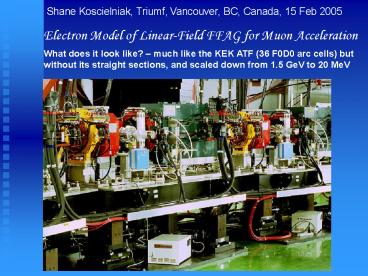nonlinear dynamics - PowerPoint PPT Presentation
1 / 8
Title:
nonlinear dynamics
Description:
much like the KEK ATF (36 F0D0 arc cells) but without its straight ... at bottom of ToF parabola ( T2/ T1= 0 instead of T2/ T1=1/3) at cost of more cells. ... – PowerPoint PPT presentation
Number of Views:113
Avg rating:3.0/5.0
Title: nonlinear dynamics
1
Shane Koscielniak, Triumf, Vancouver, BC, Canada,
15 Feb 2005
Electron Model of Linear-Field FFAG for Muon
Acceleration
What does it look like? much like the KEK ATF
(36 F0D0 arc cells) but without its straight
sections, and scaled down from 1.5 GeV to 20 MeV
2
Hardware general principle copying or
modifying existing hardware is to be preferred
over developing new designs.
Proposed magnet design the upgrade Fermilab
linac quadrupole (the 2 long green magnet). Its
peak poletip field is near 3.5 kG, the poletip
bore is 2 and has a BPM design which fits inside
the quad. With a BPM installed the aperture is
1.5. This is ideal for the 2-3 cm orbit swing
envisioned for the ring.
3
Where possible adopt designs already existing at
the host laboratory.
Radiofrequency system based around 1.3 GHz ELBE
buncher cavity to be used at Daresbury 4GLS
Adopt TESLA Linear RF distribution scheme to
reduce number of waveguides
R1M?, Q1.4?104
4
Electron Model of Linear-Field FFAG for Muon
Acceleration
What does it do? The purpose of the electron
model is to demonstrate and investigate the novel
features of a nonscaling FFAG at a small fraction
of the cost of the multi-GeV muon machine.
The FFAG operates at fixed magnetic field with a
range of central momenta spanning ?50 in ?p/p.
This has two consequences.
Resonance Crossing The transverse focusing
strength falls with increasing momentum leading
to natural negative chromaticity. This leads to
crossing of many integer and ½-integer betatron
resonances.
Gutter Acceleration The particle beam moves
across the radial aperture, during acceleration,
leading to change in orbit shape which produce a
quasi-parabolic time-of-flight variation. With
fixed radio-frequency, this necessitates
asynchronous acceleration within a rotation
manifold outside the rf bucket. (MURA 423)
5
How has the design evolved over the year(s)?
Dec 1997 Johnstone devises lattice to give
infinite momentum compaction (?? ?) at mid energy
and remarkably narrow apertues ?(dp/p)/(dL/L)
Livingood definition of compaction
- Oct 2003 J.S. Berg sets basic parameters for an
electron model (0.2T peak field, 3GHz RF, 5 15
cm drifts, 35 cm long cells) - Between Oct 2003 and April 2004, understanding of
relation between optics and ToF gleaned from muon
FFAG is applied to the model. F0D0, Doublet and
Triplet cells are all considered. - April 2004 Keil realizes that longitudinal
motion can be made less dispersive by operating
at bottom of ToF parabola (?T2/?T1 0 instead of
?T2/?T11/3) at cost of more cells. - Other designers obsessed by rings with small
circumference. - E.g.s Berg 25 cell doublet, 8.8m. Koscielniak
23 cell triplet. Trbojevic 45 cell triplet,
15.8m. Keil 45 cell doublet. - Some designs published in EPAC 2004 (MOPLT023,112
THPLT006). Keil reports alignment study via
tracking with errors.
6
How has the design evolved ? - continued
October 2004 Machida reports tolerances for
alignment and quad strength errors based on
particle tracking (i.e. integer ½-integer
resonances) former agrees with Keil (30?m
r.m.s.). Koscielniak suggests that 25-30 cell
electron model is too small too few cells and
turns (only 4 or so) adversely impacts the
study of new accelerator physics. Recommends
reducing RF and or increasing number of cells
but with fixed magnet length.
Koscielniak gives recipe for minimizing nonlinear
longitudinal emittance growth match ellipse to
boundary of constant hamiltonian. ?T2/?T1 1/5
sufficiently small
January-February 2005 all designers working on
lattices with 36,42 or more (60) cells and 1.3GHz
cavities circumference 15 to 18 m (or more).
Turns range from 7 to 10 or so.
7
Electron Model Concept/Specification consensus
with loud objections
- 10-20 MeV
- High periodicity to produce self-cancellation of
terms driving 1/3-integer structure resonances.
42 cells if affordable - No straight sections
- Doublet lattice combined function D, quadrupole
F - Iron core magnets to guarantee field quality
- Peak field at poletip less than 0.2T
- 1.3 GHz buncher-type cavities in alternate cells
- Cell length 0.42 m
- Split betatron tunes ?hgt?v
- MA cavity or induction core for resonace crossing
study - Injection/Extraction scenario -- TBA
8
Electron Model who will host?
Daresbury Laboratory U.K. is very enthusiastic to
host the electron model downstream of their
Energy Recovery Linac Prototype (ERLP) of the
4the Generation Light Source (4GLS).
M2 funding has been applied for under a Basic
Technology Grant from the EPSRC, on 11th
February. M5 will be applied for under an
European Commission program, 13th April. Final
draft of latter bid will be subject of FFAG
workshop held at FNAL 3-7 April 2005.
Thats All Folks!
Future site of electron model































